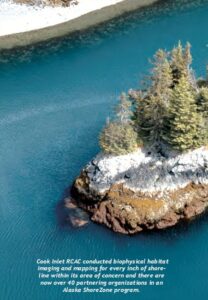Significant efforts were made during the earliest years of Cook Inlet RCAC to develop an environmental monitoring program that could begin to achieve the goals set out in OPA 90. One of the most difficult tasks was determining how to conduct a comprehensive monitoring program on a limited annual budget. The organization held workshops, solicited input from recognized experts in chemistry, toxicology, and Cook Inlet’s biology and oceanography, and obtained independent scientific reviews of study plans.
Over the years, the studies have incorporated multiple components including: intertidal and subtidal environments; sediment, water, and tissue contaminants; dissolved and particulate contaminants; water column and benthic environments; invertebrate toxicology; potential contaminant sources and sinks; targeted and background sampling in both nearfield and farfield areas; and sampling inside of produced water discharge mixing zones. The Environmental Monitoring Committee insists on using laboratories proven to meet the highest analytical standards, and requests expert, independent reviews of their studies.
Highlights of Cook Inlet RCAC’s environmental monitoring program so far include:
- Sampled hundreds of bottom sampling stations throughout Cook Inlet with a focus on a modified-sediment quality triad approach.
- Sampled over a hundred intertidal stations to assess resident algae and invertebrates, sediment contaminants and populations of potential sentinel species.
- Developed Alaska’s first surveys for the National Coastal Assessment through the Environmental Monitoring and Assessment Program (EMAP). This program assessed bottom sediment toxicity and contaminant levels and evaluated benthic fish and invertebrate diversity throughout coastal Gulf of Alaska.
- Developed the Integrated Cook Inlet Environmental Monitoring and Assessment Program (ICIEMAP) by coordinating four separate studies planned for Cook Inlet by Cook Inlet RCAC, federal agencies and industry. Together, the integrated study provided data on hydrocarbon and metal concentrations in the water column and benthic sediments as well as hydrocarbon fingerprints for mixing zones, industry areas, background Cook Inlet, and major river sources of freshwater and sediments to Cook Inlet.
- Developing a contaminants data layer for the Alaska Ocean Observing System (AOOS) website.
- Cataloged sources and discharge locations of ballast water, and implemented ballast water sampling program on the two vessels that accounted for over 90% of untreated ballast water entering Cook Inlet.











